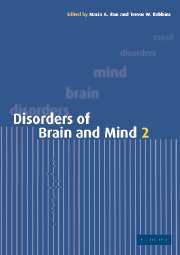Book contents
- Frontmatter
- Contents
- List of contributors
- Preface
- Part I Genes and behaviour
- Part II Brain development
- Part III New ways of imaging the brain
- Part VI Imaging the normal and abnormal mind
- Part V Consciousness and will
- 10 The scientific study of consciousness
- 11 Cognitive neurobiology of volition and agency in schizophrenia
- Part IV Recent advances in dementia
- Part VII Affective illness
- Part VIII Aggression
- Part IX Drug use and abuse
- Index
- Plate section
- References
10 - The scientific study of consciousness
from Part V - Consciousness and will
Published online by Cambridge University Press: 19 January 2010
- Frontmatter
- Contents
- List of contributors
- Preface
- Part I Genes and behaviour
- Part II Brain development
- Part III New ways of imaging the brain
- Part VI Imaging the normal and abnormal mind
- Part V Consciousness and will
- 10 The scientific study of consciousness
- 11 Cognitive neurobiology of volition and agency in schizophrenia
- Part IV Recent advances in dementia
- Part VII Affective illness
- Part VIII Aggression
- Part IX Drug use and abuse
- Index
- Plate section
- References
Summary
Introduction
Scientists rediscover consciousness
In one of the most striking developments to occur at the end of the twentieth century scientists became increasingly eager to study the physiological basis of consciousness. This was a dramatic change in attitude since for much of the early part of that century consciousness was not considered an appropriate topic for scientific study. This attitude held even for psychologists (or at least for experimental psychologists) who switched from the study of the mind to the study of behaviour on the grounds that only behaviour could be studied objectively. As is often the case, the change in attitude which led to the study of consciousness was driven by advances in technology. The development of information theory (Shannon and Weaver 1949) enabled the construction of digital computers and had a strong influence on psychology (Attneave 1959). Computers were ‘electronic brains’. Computer engineers were not restricted to studying the behaviour of these thinking machines. They could study directly mechanisms of memory and perception both in terms of the computations that achieved these functions and in terms of the electronic hardware that made the computations. Psychologists applied the same ideas to the study of thinking people. They began to speculate about the invisible processes that enabled behaviour to occur. This new study of ‘information processing’ led on to the development of cognitive psychology, now the dominant approach.
- Type
- Chapter
- Information
- Disorders of Brain and Mind , pp. 197 - 222Publisher: Cambridge University PressPrint publication year: 2003
References
- 1
- Cited by



